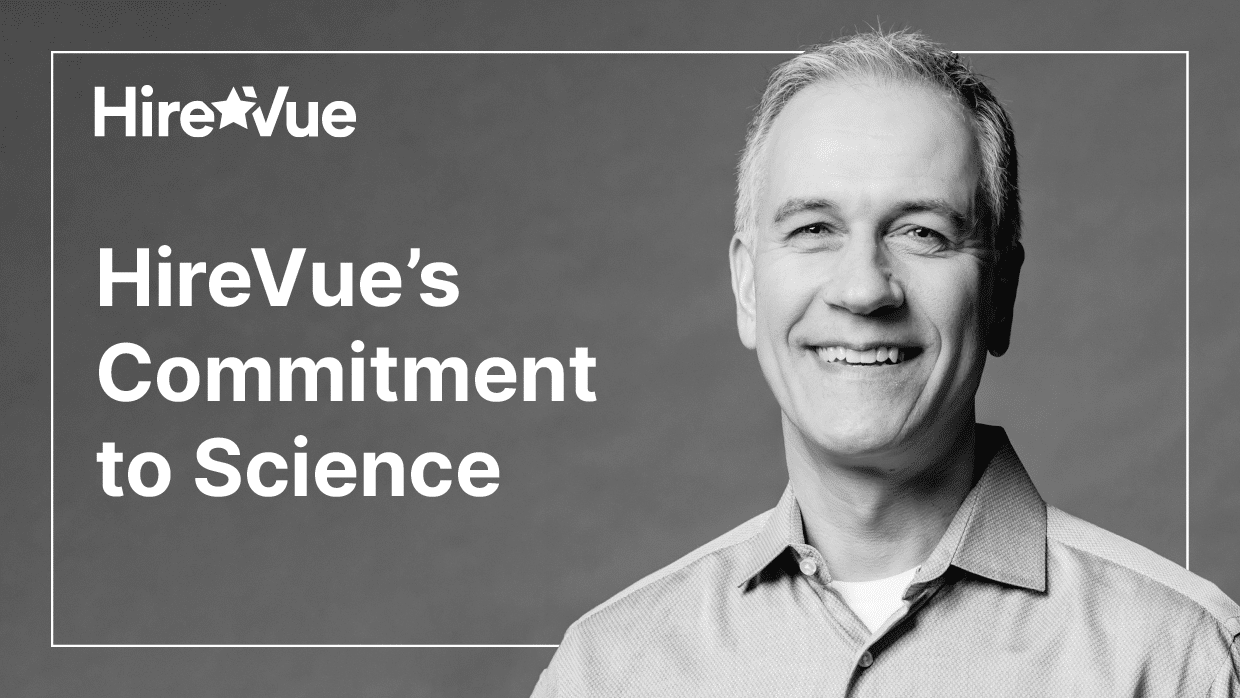How Hirevue approaches research and innovation in HR tech

I’ve been an Occupational Psychologist for over 25 years, and have seen the field grow tremendously in the time since I helped found Shaker, which eventually became Modern Hire. Even with the expansion of the field, most of us have formed a strong network. We read each other’s papers, submit to the same journals and conferences, and have either worked together or competed against each other for what feels like ages. Not a week goes by that I don’t hear someone say how small the IO community is.
HireVue’s acquisition of Modern Hire is exciting in many ways, but chief among them for me is the way our Science Teams are now coming together. We’ve been researching adjacent projects for years, and now we get to collaborate and push our respective fields even further as a combined force. We’ve always kept tabs on each other’s academic bonafides, even as we came up against each other in so many RFP processes.
In my new role as Chief Science Officer at HireVue, I get to evangelize the core science DNA that touches all aspects of our business – including our people, culture and clients. A part of this new role is working closely with Dr. Lindsey Zuloaga, HireVue’s Chief Data Scientist and Dr. Nathan Mondragon, HireVue’s Chief Occupational Psychologist, as we define our combined scientific point of view.
You could say this blog post is a part of that coming together, we’re sharing high-level themes about how our go-forward organisation will approach research and innovation.
Access to employment is a high stakes decision and selection must prioritise ethics
A person’s access to employment, where they work, and their satisfaction with how they contribute their talents to the market impacts health and well-being. Employment affects every aspect of life and it is critical that we as scientists never lose sight of our deep responsibility to ensure that hiring is as transparent and fair as possible.
Our teams are currently reviewing each of our public sets of ethical principles to determine how we update them into a single source of truth. While the principles are quite similar, we think it’s a good time to create a new set that combines the best of both perspectives and incorporates the new realities of today (e.g. generative AI and AI regulation).
These principles will guide us in everything we do and always point back to the importance of the decisions within people’s lives.
Continuous improvement requires rigourous academic engagement
I mentioned how tight knit the IO community can be, and this was on full display at this year’s Society for Occupational Psychology’s Annual Conference. Our respective teams were locked into the confidential process of acquisition, unsure who on each team knew what as we set up booths not far from each other, listened in on each other’s presentations (there were over 22 between the teams) and tried not to be too conspicuous as we stole glances of each other’s panels.
This gets to something we will continue to lead from the front on: we are actively engaged in cutting-edge research within our respective fields of inquiry. You can find one of our team member’s names on nearly every speaking agenda or attendee list of industry trade shows and major academic conferences because this type of work is fundamental to designing tools that benefit our customers, their candidates, and society.
All of our research and applications will continue to uphold scientific standards, including the use of representative samples and peer review. We have to produce software that is driven first and foremost by science.
Transparency and explainability are the future of AI
We promote algorithmic transparency over black box approaches. Rather than simply allow algorithms to operate in an opaque or black box manner, we work to ensure clarity in model design. It is vital that the inner workings of complex algorithms be understood as making rational sense and that they do not base scores on spurious relationships or potentially biasing factors. We accomplish this through an IO led approach – that is, theory and best practice are the foundation of our approach and data science enables us to scale these best practices. Our team of Occupational Psychologists and Data Scientists work to ensure that the factors driving hiring predictions are logical and explainable to outsiders.
HireVue’s industry-first AI Explainability Statement, its series of 3rd party audits, and ongoing testimony and contributions regulators demonstrate a commitment to transparency and explainability, and we will only improve as a combined team from here.
Looking ahead
Combining two organisations is never as simple as you’d like, but sixty days into the acquisition, and I’m pleased to say there is great agreement and similarity in the scientific building blocks of how we do business. Right now it’s all about refining and improving what we both did well to create something even more extraordinary for our customers and their candidates.
I’m looking forward to meeting with many of you soon in this new role, and if you have any questions, suggestions or feedback about what you’ve read here today, please feel free to connect with me on LinkedIn.
Best,
Mike Hudy
Chief Science Officer



